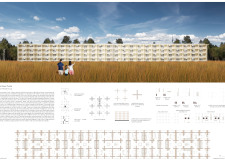5 key facts about this project
The Green Puzzle is a thoughtful solution aimed at affordable housing in Toronto. It exists in a city where the need for better living options is growing. The design incorporates a modular approach, allowing it to cater to individuals, couples, and families. A notable feature is its grid structure made from cross-laminated elements, which emphasizes flexibility and effective space use.
Modular Construction
The design employs a grid system of cross-laminated structural elements. This method supports the quick assembly of housing units. By removing traditional corridors, the layout creates a spacious and open environment within each apartment. Such an arrangement not only maximizes usable space but also makes the homes feel larger and more inviting.
Spatial Organization
Each unit centers around fixed utility points, such as kitchens and bathrooms, which streamline plumbing and mechanical setups. This design enhances the functionality of the apartments. The modular nature allows for different living arrangements to be easily created, accommodating changing needs over time. This adaptability makes it practical for a diverse range of residents.
Sustainability Features
Wood is the primary material used in the Green Puzzle. This choice reflects a commitment to sustainability and responsible building practices. Using wood reduces the environmental impact associated with construction. Additionally, its capacity for prefabrication speeds up the building process. This aligns with current goals for environmentally friendly development.
Design Diversity
The structure's design allows for various apartment configurations, serving single individuals, couples, or larger families. The flexibility enables larger apartments to be divided or smaller units combined, responding to the dynamic needs of urban living. This thoughtful approach fosters community, offering varied living options within a single project.
The Green Puzzle merges modular design and sustainability in a way that addresses contemporary housing needs. The result is a functional living space that adapts to the changing lifestyles of its residents while promoting an efficient and environmentally aware approach to urban living.



















































